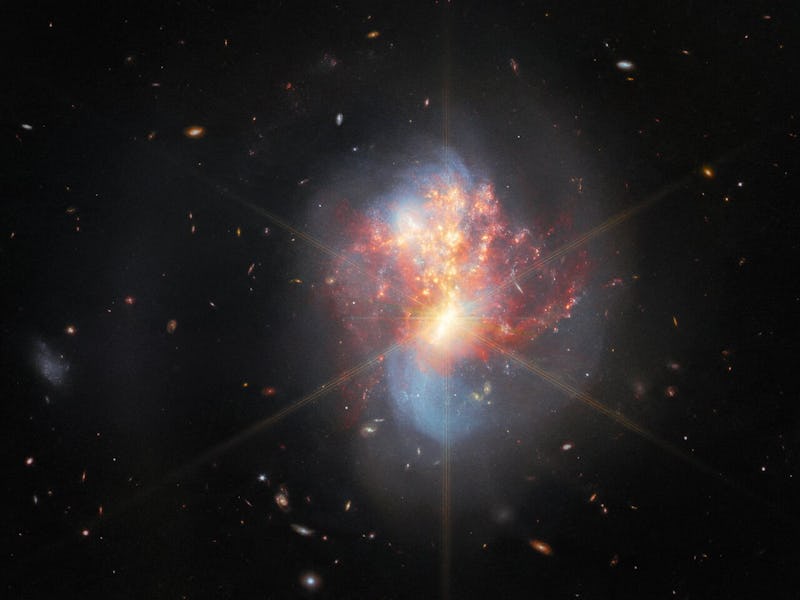Galaxies collide in stunning new Webb Telescope image
Webb's instruments shed new light on the merger between two galaxies and a brilliant burst of star formation.

In the James Webb Space Telescope’s newest image, a pair of galaxies are smashing together, triggering waves of new star formation. And in the bright heart of the collision, we may be witnessing the birth of a new supermassive black hole.
Around 270 million light years away, it’s hard to tell where one galaxy ends and the other begins. The merging galaxies of IC 1623 have very nearly become one object already. It’s a tale as old as time — two galaxies, caught up in each other’s gravitational pull, spiral closer and closer together, falling toward a common center of gravity until, at last, they merge into a single larger galaxy.
Most of the large, intricately-structured spiral galaxies in the nearby universe probably evolved this way, from generations of smaller galaxies colliding and merging to former ever-larger, more complex ones.
Three of Webb’s instruments — the Mid InfraRed Instrument, the Near Infrared Spectrometer, and the Near Infrared Camera — produced this breathtaking image of the merging galaxy pair called IC 1623.
We tend to think of galaxies as being made of stars — billions of them arranged in huge, swirling disks with bright, dense cores and spiral arms. But much of the stuff that makes up a galaxy is just gas and dust — gargantuan clumps, filaments, and bands of it in the space between the stars. Webb is especially good at seeing things like that interstellar dust: relatively cool and dark, glowing in the infrared wavelengths only thanks to its own heat.
IC 1623, a pair of merging galaxies 270 million light years away, looks very different in optical, near-infrared, and mid-infrared light.
When two galaxies merge, those huge clouds of interstellar gas and dust get shoved together, which creates areas of denser, hotter material. And in the densest patches of gas, the sudden pileup of more material is enough to cause some especially massive clumps to collapse under their own weight, flaring to life as new stars. These waves of new star formation show up in this latest Webb image as bright gold bubbles amid the red background of heated gas. Some of those bright patches, compressed by the galactic collision, are churning out new stars at roughly 20 times the rate of our own galaxy.
The Hubble Space Telescope turned its Wide Field Camera 3 on IC 1623 more than a decade ago, but its optical and ultraviolet instruments couldn’t see through thick bands of dust to the heart of the action: the merging cores of the two galaxies.
Hubble sees the universe in shorter wavelengths of light than Webb, so its view of IC 1623 looks different — but still spectacular.
Infrared instruments like Webb’s MIRI are very good at seeing through the curtains of dust that block shorter wavelengths of light, though. And in the newest Webb image, the core of IC 1623 blazes so brightly that it shows up with six long, bright diffraction spikes thanks to the way its light strikes Webb’s six-sided mirror segments — something that usually only happens with bright, nearby stars in our own galaxy. According to the European Space Agency, the supermassive black holes that once formed the separate centers of two galaxies are now merging into a single enormous supermassive black hole at the heart of the new, larger galaxy.
IC 1623 gives astronomers a chance to tackle some of the most important parts of Webb’s science mission: how large galaxies evolve, how supermassive black holes form, and the causes and effects of star formation on a massive scale.
This article was originally published on